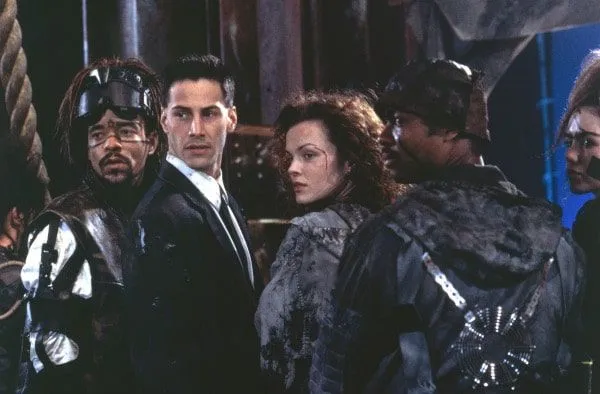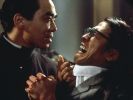Eye For Film >> Movies >> Johnny Mnemonic (1995) Film Review
Johnny Mnemonic
Reviewed by: Andrew Robertson

Johnny Mnemonic sits within the litany of visions of a future now past. In a new digital transfer, the events of January 2021 as they move from Beijing to Newark and from high to "Lo-Tek" are ever harder to read independently. The film itself is one whose production has influenced others, the number of nods in design and tone both from and to it are not insignificant. It is one of the few filmed versions of William Gibson's work, one of a cadre of novelists of the near future whose works possess a tonal identity that makes them adjectival.
Gibson wrote the screenplay, though in some circles might be more notable for having written one of the many treatments for what would become Alien³. Adapted from his own short story, one of the many in the collection Burning Chrome, the memorable protagonist of that story is different streets away from Keanu Reeves' portrayal. This is Reeves before The Matrix, when his appearance in a film with Dolph Lundgren is an indicator of willingness to genre and not (solely) a post-ironic cash-in. Udo Kier rocks up, Ice-T too, and that is not the only reference made to The Terminator.

Famous faces abound. There's Takeshi Kitano, Henry Rollins, the blank slate of Reeves himself. As with Kristen Stewart, a tremendously capable performer, but it's certain directors who can elicit or capture them properly. Robert Longo made his feature directorial debut here, and hasn't made a film since. Reeves has worked for Bigelow, Coppola, the Wachowskis. Here, in 1995, he was fresh from Speed, about to have a very similar ending in the workmanlike Chain Reaction, to watch Pacino chew (and get chewed by) scenery in The Devil's Advocate. Here, in 1995, Cyberspace features the logos of AT&T without the remove of Atari in Blade Runner, when they talk of "eyephones" it's goggles not Apples. Phone calls are made using flat rectangles that are swiped rather than swiped upon. This is what the future was going to look like until the people who were going to make it saw it.
I've seen the film before, of course. Have an annotated copy of Burning Chrome in my bookcase. Though in truth the story from that collection that stands out is Fokkers And Spads, a tale I think about whenever I ponder certain miniature wargames or certain drugs or the Washington Monument. Johnny Mnemonic always makes me think of white sports socks, not because Keanu's clad in them in an increasingly dishevelled suit, but as padding material at the intersection of the crude and the technical.
Padding appropriate, because the film, despite being a pretty solid A to B with stacked McGuffins, still finds time to meander. It opens with a screen full of exposition, without the benefit of a skyline as iconic as the flaming Los Angeles of 2019. The emptiness of Johnny (just Johnny, it's easy to remember) and his existence is palpable. Relationships are cold with or without ice. A rant about the way they starch collars at the Imperial Hotel presages the empty acquisition that was railed against in Fight Club. This is aspirational in ways now gone. There are no supersonic transports, there are no data gloves unless you count the ones you can unlock your smartphone with. The corporations don't need the Yakuza, they're criminal enough by themselves.
The restored version is crisp. Indeed, with it I noticed just how much television there is, beyond the presence of Demon City Shinjuku in the hotel room the biggest screens are projections. There's the iconic Lo-Tek tower, a vortex of cathode ray tubes. There's back projection and some dodgy compositing too. Age has not been kind to many of the effects. Some have weathered well, there's a certain otherworldly charm to the painted patterns of the monofilament thumb. Others less so, in a number of places the joins are more than visible. I mention Blade Runner again because this is a film that legend has it was not allowed to develop smoothly. There are other versions. One might be out there with fewer reaction shots, less exposition delivered through clumsy interlocution. Behind the camera, DoP Francois Protat had plenty TV movies to his credits but too often this film feels like it was shot for mid-budget network somewhere between Seattle and Vancouver. It's as much an oddity now as the references to VCRs, a spur not taken or left undeveloped.
It's still entertaining. In cruelty, not always intentionally. I laughed out loud at a shot of a satellite, and felt bad. It's crisp model work, a fleeting shot to convey international reach, and in space weathering works differently. That said it felt false, more so than anything that leaked from Videodrome. In a future so carefully gritty and glossy it's so astonishingly artificial that it makes the ersatz cetacean look more convincing. There's an action movie one-liner "next time knock baldie" that's so weirdly forced that it almost becomes art. Does Johnny say it because he feels he has to?
Other bits date it. It was the future as seen from what is now the past, so everyone smokes. Not just so that we can see that a digital component is the size of a packet of cigarettes either. Though the volumes involved are seemingly trivial (320 Gigabytes) they couldn't know that Moore's Law would still be working. That's the computer one, not Roger. Though the sense that no matter how sharply dressed a martial artist can still make use of it isn't entirely missing.
There are some thematic elements that tantalise, though many never quite develop. We see Johnny centre himself with Tai Chi reflected in three mirrors. Doubles abound, and not just in cyberpace. Salarymen and henchmen, doctors and dealers, the twisted dog sisters and wired and weird. All are bound up in versions of each other. The climactic confrontation(s) are on a bridge to nowhere. There are moments where it seems they've lost their way around the massive set, the dimensions of the Brooklyn Bridge were never more or less certain. Echoes of other Gibsonian entities, the Golden Gate informs the Bridge Trilogy which comes after the Sprawl Trilogy. Johnny turns up in the latter, Virtual Light shone on a community on a cut-off connection roughly contemporaneously with this outing.
If it seems like I've mentioned a lot of other work it's because there's a lot going on. Too much, perhaps, as with High-Rise, or as is often the case too little. That which menaces is never as hidden as the antoganist of Jaws, and that which saves is never as clear as elsewhere. The influences of this film reach from Dark City to Elysium and any number of stately satellites between. Yet now it's perhaps as much a historical artifact as entertainment. Even within itself there are odd datings - the visions Johnny has are mansions of seeming madness, perhaps intended as a soft visual translation of his perceptions of them. Old comfort and wealth. Though perhaps they are missed because they weren't worth keeping, synechdoche.
The soundtrack holds up well in places. Orbital for a start, Rollins from the cast too. The contractual oddities that mean there is a song by Bono and The Edge but not by the other two from U2 raise questions, but not as many as the rest of the film. What we've got here is about 90 minutes, not the 100+ of the Japanese cut. We still don't see one of the heroes' heroin, and the absence of Molly Millions is down to rights being sold elsewhere. The credits still mention the simultaneous release of the soundtrack on CD and cassette. The film still doesn't work, but not for lack of effort expended.
In truth the best film to come from this is probably yet to. Memory, Future-Shock, Jodorowsky's Dune all explore artists and areas that would influence those artists and areas that this film would influence. Time has not been kind in places. Lundgren wouldn't have a film role for 15 years after this, almost as long as it took the tale to go from publication in Omni to the silver screen. Reeves would become a cyberpunk action star, but not like this. Even now as Johnny Silverhand there's a doubling, Mike Pondsmith's roleplaying game had its greatest run between the short and the film, but it's as much Mnemonic as Matrix that informs the rockerboy.
There are completists who will want to see this, and see it they should. The benefit of it is as much from novelty as quality. This isn't great, indeed in places not even good filmmaking, but it still fascinates, and rightly. Cyberpunk is a genre (like most others) about which there are ready arguments, and in Johnny Mnemonic many of those arguments are made flesh. For Gibson fans this is still one of the few filmed versions of his work. YouTube archaeologists may have seen a British short based on the Gernsback Continuum, and we've now a graphic novel of the unfilmed script he did for the third Alien film. For Reeves fans, well, he's not got any good one-liners but he is impassioned and compassionate, less tabula rasa than palimpsest. For hardcore cyberpunks if any still exist, then this is a foundational document, flaws and all. For anyone else? File not found.
Reviewed on: 09 May 2021


















